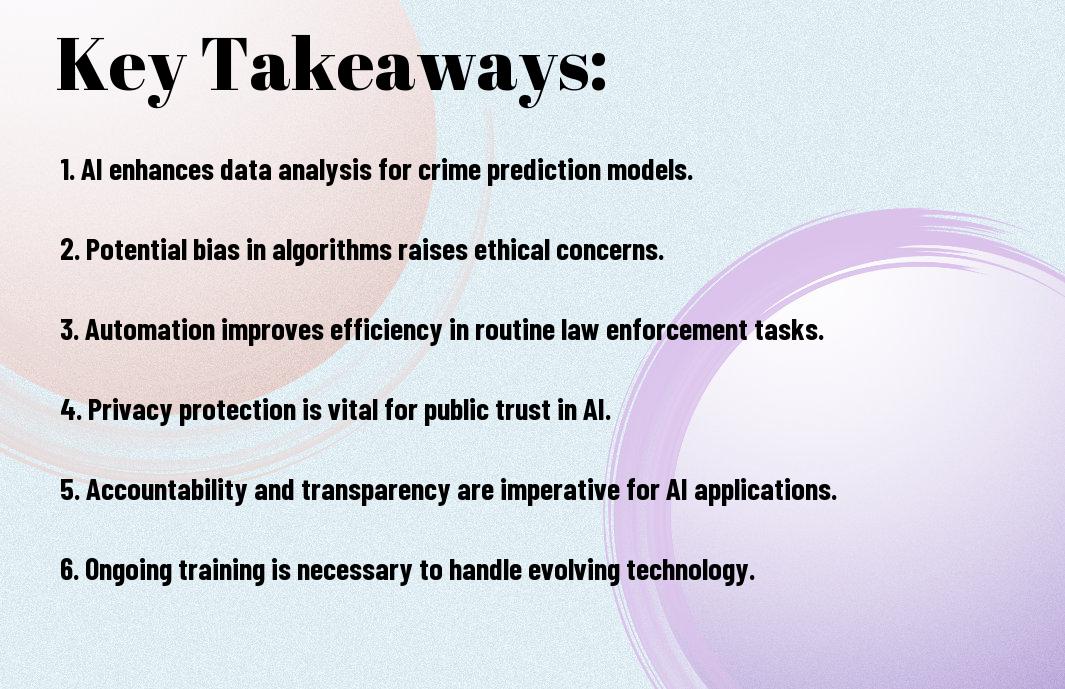As you consider the integration of artificial intelligence into law enforcement, you are likely weighing the potential benefits and drawbacks. You may wonder how AI agents can enhance your understanding of crime patterns and improve response times. Your curiosity about the role of AI in law enforcement is well-founded, as it has the potential to significantly impact the field. You will explore the opportunities and risks associated with AI agents in law enforcement, examining how they can aid in investigations and decision-making, while also considering the potential consequences of reliance on automated systems.

Key Takeaways:
- The use of AI Agents in law enforcement presents several Opportunities, including enhanced Predictive Policing capabilities, improved Crime Detection, and increased Efficiency in investigating and solving cases.
- The integration of AI Systems in law enforcement also poses significant Risks, such as Bias in decision-making algorithms, potential Violations of individual Privacy, and the need for Transparency in AI-driven decision-making processes.
- Effective deployment of AI Agents in law enforcement requires careful consideration of these Opportunities and Risks, as well as ongoing Monitoring and Evaluation to ensure that AI Systems are used in a Responsible and Accountable manner.

Advantages of AI in Law Enforcement
Among the various benefits of AI in law enforcement, you will find that it can greatly enhance your operations and decision-making processes. As you explore into the applications of AI, you will notice improvements in efficiency, accuracy, and overall effectiveness.
Enhanced Efficiency
Above all, AI can help you streamline tasks and automate routine procedures, allowing your team to focus on more complex and high-priority cases.
Improved Accuracy
Ensuring the accuracy of evidence and data analysis is vital, and AI can help you achieve this by minimizing human error and providing objective insights.
Considering the potential of AI to improve accuracy, you can expect to see significant reductions in wrongful convictions and miscarriages of justice, as AI systems can analyze vast amounts of data and identify patterns that may elude human investigators, thereby helping you build stronger cases and make more informed decisions.
Risks Associated with AI in Law Enforcement
You will encounter several risks when implementing AI agents in law enforcement, including bias, discrimination, and lack of accountability.
Bias and Discrimination
One of the primary concerns is the potential for AI systems to perpetuate existing biases and discriminate against certain groups, which can lead to unfair treatment and outcomes.
Accountability and Transparency
Between the complexity of AI decision-making processes and the lack of human oversight, it can be challenging to hold AI agents accountable for their actions and ensure transparency in their operations.
Due to the autonomous nature of AI agents, it is imperative to establish clear guidelines and protocols for their development, deployment, and use in law enforcement, allowing you to track their decision-making processes and identify potential errors or biases, and ensuring that you can hold them accountable for any mistakes or wrongdoing, which is vital for maintaining public trust and legitimacy in the use of AI in law enforcement.
Current Applications of AI in Law Enforcement
Many law enforcement agencies are leveraging AI to enhance their operations, from predictive policing to investigation and evidence analysis. You can explore various AI applications in law enforcement, including data analysis and surveillance.
Predictive Policing
Beneath the surface of traditional policing methods, AI-powered predictive policing allows you to forecast crime patterns, enabling proactive measures to be taken. You can utilize AI algorithms to analyze historical crime data and identify high-risk areas.
Investigation and Evidence Analysis
Upon examining the role of AI in investigations, you will find that it aids in analyzing evidence, such as DNA and fingerprints, to solve crimes more efficiently. You can use AI to connect the dots between seemingly unrelated pieces of evidence.
Plus, as you examine deeper into investigation and evidence analysis, you will discover that AI facilitates the processing of large amounts of data, helping to identify patterns and leads that may have gone unnoticed by human investigators. You can apply AI to streamline your investigative processes, making them more effective and efficient.
Ethical Considerations
After implementing AI agents in law enforcement, you will encounter various ethical dilemmas that need to be addressed, including issues related to privacy, bias, and accountability, which can impact your trust in these systems.
Privacy Concerns
Privately, you may wonder how AI agents will handle sensitive information, and you should consider the potential risks of surveillance and data misuse, which can affect your personal life and security.
Human Oversight and Control
Among the key concerns is ensuring that you have control over AI decision-making processes, and you should consider the need for human oversight to prevent potential errors or biases in AI-driven law enforcement operations.
Considerations regarding human oversight and control involve evaluating the level of autonomy you are willing to grant AI agents, as well as establishing clear guidelines and protocols for their use, and you should weigh the benefits of AI-driven efficiency against the potential risks to your civil liberties and privacy.
Future Developments and Challenges
For the successful integration of AI agents in law enforcement, you will need to consider the potential implications of emerging technologies. As you explore the possibilities, you must also acknowledge the challenges that lie ahead, including ensuring accountability and transparency in AI decision-making processes.
Integration with Emerging Technologies
Besides the current applications, you can expect AI agents to be integrated with other emerging technologies, such as the Internet of Things (IoT) and blockchain, to enhance their capabilities and efficiency in law enforcement.
Addressing Public Perception and Trust
Trusting the use of AI agents in law enforcement is crucial, and you should be aware that addressing public perception is vital to their successful implementation, as you will need to balance the benefits of AI with concerns about privacy and bias.
Plus, as you examine deeper into the issue of public perception, you will find that building trust in AI agents requires a thorough understanding of their decision-making processes and ensuring that they are aligned with your values and ethical principles, which is necessary for their widespread acceptance and effective use in law enforcement.
Regulatory Frameworks and Guidelines
Now, as you explore the role of AI agents in law enforcement, you will encounter various regulatory frameworks and guidelines. For instance, you can learn more about Managing the Risks of Public Safety Artificial Intelligence to better understand the complexities involved.
Existing Laws and Regulations
By examining current laws and regulations, you will gain insight into the ongoing efforts to govern AI agents in law enforcement, shaping your understanding of the field’s development.
Proposed Reforms and Updates
Any proposed reforms or updates to regulatory frameworks will likely impact the future of AI agents in law enforcement, influencing your perception of their potential applications.
The proposed reforms and updates aim to address concerns surrounding AI agents, such as bias, accountability, and transparency, allowing you to consider the potential implications of these developments on your understanding of the technology and its role in law enforcement, ultimately informing your perspective on the opportunities and risks associated with AI agents in this context.
Conclusion
Summing up, you now have a better understanding of the dual nature of AI agents in law enforcement, presenting both opportunities and risks. As you weigh the benefits of enhanced efficiency and accuracy against the potential pitfalls of bias and accountability, your perspective on this technology will shape your stance on its integration into your community’s law enforcement strategies, ultimately influencing your safety and trust in the system.
FAQ
Q: What are the opportunities of using AI agents in law enforcement?
A: The integration of AI agents in law enforcement presents several opportunities, including enhanced predictive policing capabilities, improved evidence analysis, and more efficient management of emergency responses. AI can analyze vast amounts of data quickly and accurately, helping to identify patterns and potential crime hotspots, thus enabling proactive measures to be taken. Furthermore, AI-powered systems can assist in sorting through evidence, such as footage and digital communications, to help solve cases more swiftly. This not only helps in reducing crime rates but also in improving public safety and trust in law enforcement agencies.
Q: What are the risks associated with the use of AI agents in law enforcement?
A: While AI agents offer significant benefits to law enforcement, their use also poses several risks. One of the primary concerns is bias in the algorithms used by these systems. If the data used to train AI models contains biases, the decisions made by these systems can perpetuate and even amplify existing social inequalities, leading to unfair treatment of certain groups. Additionally, there are concerns about privacy and surveillance, as AI can be used to monitor individuals at an unprecedented scale. The reliance on AI also introduces technological vulnerabilities, such as the potential for system failures or hacking, which could compromise investigations or public safety. Lastly, over-reliance on AI could lead to a decrease in human judgment and empathy in law enforcement decisions, potentially leading to unjust outcomes.
Q: How can law enforcement balance the opportunities and risks of using AI agents?
A: To balance the opportunities and risks of AI agents in law enforcement, agencies must adopt a thoughtful and multi-faceted approach. This includes ensuring transparency in how AI systems are developed and used, implementing rigorous testing for bias, and establishing clear guidelines for when and how AI tools are deployed. Continuous training and education for law enforcement personnel on the use and limitations of AI is also imperative. Moreover, fostering collaboration between technologists, ethicists, and law enforcement professionals can help in identifying and mitigating risks early on. Finally, establishing independent oversight mechanisms to monitor the use of AI in law enforcement and address any issues that arise can help in building public trust and ensuring that AI serves to enhance, rather than undermine, justice and public safety.

